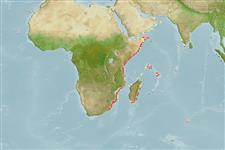Holocéfalos (quimeras) (chimaeras) >
Chimaeriformes (Chimaeras) >
Chimaeridae (Shortnose chimaeras or ratfishes)
Etymology: Hydrolagus: hydro-, combining form of hydor (Gr.), water; lagos (Gr.), hare, i.e., “water rabbit,” probably referring to three pairs of tooth plates, which tend to protrude from the mouth like a rabbit’s incisors. (See ETYFish); africanus: -anus (L.), belonging to: Africa, described from deep water off the KwaZulu-Natal South Coast of South Africa. (See ETYFish).
Environment: milieu / climate zone / depth range / distribution range
Ecología
marino batidemersal; rango de profundidad 421 - 750 m (Ref. 3181). Deep-water
Western Indian Ocean: off Kenya, Mozambique and Natal, South Africa.
Tamaño / Peso / Age
Maturity: Lm ? range ? - ? cm
Max length : 67.0 cm TL macho / no sexado; (Ref. 3181)
Short description
Claves de identificación | Morfología | Morfometría
Espinas dorsales (total) : 1; Espinas anales: 0; Radios blandos anales: 0. A shortnose chimaera with the dorsal fin spine longer than the head; 2nd dorsal fin with distinct concavity in the middle (Ref. 5578).
Feeds on ophiuroids (Ref. 27637). Oviparous (Ref. 205). Eggs are encased in horny shells (Ref. 205).
Life cycle and mating behavior
Maturities | Reproducción | Spawnings | Egg(s) | Fecundities | Larva
Compagno, L.J.V., 1986. Chimaeridae. p. 144-145. In M.M. Smith and P.C. Heemstra (eds.) Smiths' sea fishes. Springer-Verlag, Berlin. (Ref. 3181)
IUCN Red List Status (Ref. 130435)
Human uses
Pesquerías: sin interés
Herramientas
Special reports
Download XML
Fuentes de Internet
Estimates based on models
Preferred temperature (Ref.
123201): 8.9 - 11.4, mean 9.7 °C (based on 16 cells).
Phylogenetic diversity index (Ref.
82804): PD
50 = 0.5000 [Uniqueness, from 0.5 = low to 2.0 = high].
Bayesian length-weight: a=0.00282 (0.00118 - 0.00673), b=3.10 (2.89 - 3.31), in cm total length, based on LWR estimates for this (Sub)family-body shape (Ref.
93245).
Nivel trófico (Ref.
69278): 4.1 ±0.60 se; based on food items.
Resiliencia (Ref.
120179): Bajo, población duplicada en un tiempo mínimo de 4.5-14 años (Assuming Fec <100).
Fishing Vulnerability (Ref.
59153): Moderate to high vulnerability (47 of 100).
